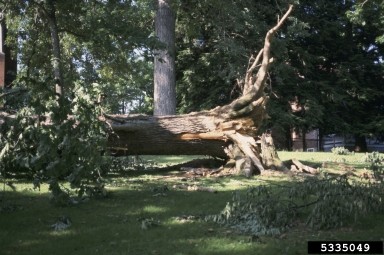Storms
Severe storms expose trees to a combination of many of the most destructive atmospheric stress agents in a short period of time. It is not uncommon for trees to experience heavy rains, saturated soils, strong winds, snow, ice, hail, and/or lightning during a single storm event. Severe damage or mortality often cannot be avoided during the worst storms, but proper tree care starting with the right species selection for the site, appropriate stocking density, and/or pruning when appropriate can minimize damage during less severe events.
Large trees should never be “topped”; topping can cause extensive decay pockets and induce epicormic sprouting that gives rise to weakly attached branches that easily break during storms. Care should be taken to regularly examine trees that pose potential hazards to people or structures. Fruiting bodies, holes, or sunken areas on the main stem may indicate areas of decay or weak points that may fail during a storm. After large storm events, trees should be assessed for immediate damage, and be monitored for several years for secondary insects and diseases.
